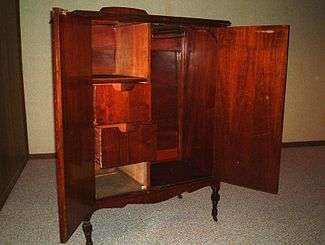Chifforobe

A Chifforobe (/ˈʃɪfəˌroʊb/) is a closet-like piece of furniture that combines a long space for hanging clothes (that is, a wardrobe or armoire) with a chest of drawers.[1] Typically the wardrobe section runs down one side of the piece, while the drawers occupy the other side.[2] It may have two enclosing doors or have the drawer fronts exposed and a separate door for the hanging space.[2][3]
Chifforobes were first advertised in the 1908 Sears, Roebuck Catalogue, which described them as "a modern invention, having been in use only a short time." The term itself is a portmanteau of the words chiffonier and wardrobe.[4]
The word is used in the United States, primarily in the southern portion of the country,[5] in Puerto Rico,[6] and in Cuba. Its use has been attested as far apart as Georgia and Vermont.[3] In those references, it was used as a water closet or potty (or more accurately a commode).[3] The word has been used in Texas, but is not as common as its synonyms such as bureau or dresser.[2]
In media
- "Chiffarobe" appears eleven times in Harper Lee's novel To Kill a Mockingbird. For instance, Tom Robinson "busts up a chiffarobe" for Mayella Ewell.[7]
- Hazel Motes, in Flannery O'Connor's Wise Blood, leaves a note on his mother's abandoned "chifforobe" warning thieves will be found and killed.[8]
- It also appears repeatedly in Bastard Out of Carolina by Dorothy Allison.[9]
- Judth Ortiz Cofer, recalled a "monstrous chifforobe" from her youth in Puerto Rico,[6]
- There are also many references to "chifforobe" in Kathryn Stockett's The Help and in Ron Rash's novel Serena.
- This term is also used in the novel The Color Purple by Alice Walker. There, the main character Celie describes that patting Harpo feels "like patting another piece of wood. Not a living tree, but a table, a chifferobe." Later in the book, Celie is not happy about the way she looks, and in that context she contemplates: "Nothing but churchgoing clothes in my chifferobe."
- The chifforobe is an important element of the film Pride of the Yankees. Lou Gehrig's mother purchases a chifforobe as a wedding present for newlywed Lou and his bride Eleanor. The fact that Eleanor is not pleased with it has ramifications for her relationship with her mother-in-law.
- Mentioned by Penny Wharvey McGill in "Oh Brother, Where Art Thou" in regards to the possible location of her ring (after Ulysses Everett finds someone else's ring in the flood from the reservoir.)
Notes
- ↑ Dictionary.com website. n.d.
- 1 2 3 Elmer Bagby Atwood, The regional vocabulary of Texas, p. 44 (University of Texas Press, 1962) ISBN 978-0-292-77008-9. Found at Google Books. Accessed July 7, 2011.
- 1 2 3 Walter J. Brown, J.J. Brown and Thomas E. Watson: Georgia politics, 1912-1928, p. 24 (Mercer University Press, 1989) ISBN 978-0-86554-322-5. Found at Google Books. Accessed July 7, 2011.
- ↑ Catherine O'Reilly, Did Thomas Crapper Really Invent the Toilet?: The Inventions That Changed Our Homes and Our Lives, p. 30 (Skyhorse Publishing Inc., 2008) ISBN 978-1-60239-347-9. Found at Google Books. Accessed July 7, 2011.
- ↑ Frederic Gomes Cassidy, Joan Houston Hall, Dictionary of American regional English, Volume 4 (Belknap Press of Harvard University Press, 2002) ISBN 978-0-674-00884-7. Found at Google Books. Accessed July 7, 2011.
- 1 2 Judith Ortiz Cofer, Silent dancing: a partial remembrance of a Puerto Rican childhood, p. 24 (Edition 2, Arte Publico Press, 1990) ISBN 978-1-55885-015-6. Found at Google Books. Accessed July 7, 2011.
- ↑ Horton Foote, To kill a mockingbird ; Tender mercies ; and, The trip to Bountiful: three screenplays, p. 59 (Grove Press, 1989) ISBN 978-0-8021-3125-6. Found at Google Books. Accessed July 7, 2011.
- ↑ O'Connor, Flannery (2008). Wise Blood. London: Faber and Faber. p. 16. ISBN 978-0-571-24130-9.
His mother had always slept in the kitchen and had her walnut chifforobe in there. [...] He took the wrapping cord and tied it around the legs and through the floor boards and left a piece of paper in each of the drawers: THIS SHIFFER-ROBE [sic] BELONGS TO HAZEL MOTES. DO NOT STEAL IT OR YOU WILL BE HUNTED DOWN AND KILLED
- ↑ Dorothy Allison, Bastard Out of Carolina, (Penguin, 1993) ISBN 978-0-452-26957-6. Found at Google Books. Accessed July 7, 2011.
- ↑ Cormac McCarthy. No Country for Old Men. p146
